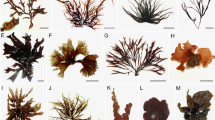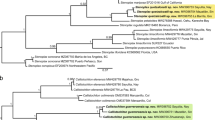Abstract
In the absence of reliable morphological characters, or in conjunction with morphology-based identifications, meiofaunal turbellarians may also be identified using the nucleotide sequence of a portion of the large subunit of the ribosomal RNA (26/28S rRNA). A 284 base pair-long region of the 26/28S rRNA has been identified by isolating genomic DNA from ten species of turbellarians belonging to four orders, namely, the Proseriata, Macrostomida, Prolecithophora and Acoela. The proseriates had been collected from localities in Europe and Israel and were preserved in ethanol. The remaining turbellarians were isolated from intertidal sediment samples collected from two sites on the Maine and New Hampshire coast, USA in 1992. Amplification of the genomic DNA was carried out using two primers designed to match the nucleotide sequence of a portion of the 26/28S rDNA gene of the terrestrial nematode,Caenorhabditis elegans (Maupas 1900). This area consists of a highly variable, about 150 base pair-long region, called the D3 expansion segment, followed by a very conserved stretch of sequence. When folded into its secondary structure, the conserved region will form stem structures that correspond to helices 15 to 18 of theC. elegans structural model. The sequence alignment program PILEUP was used to perform a cluster analysis (unweighted pair group method using arthmetic averages, UPGMA) on the sequences. This analysis revealed that the helices allow for the classification of the turbellarians at the level of families and above, whereas if the D3 expansion segment itself was included in the analysis, intrageneric and intraspecific groupings could be established.
Similar content being viewed by others
References
Arnheim N (1983) Concerted evolution of multigene families. In: Nei M, Koehn RK (eds) Evolution of genes and proteins. Sinauer, Sunderland, Massachusetts, pp 38–61
Avise JC, Arnold J, Ball RM, Berminham E, Lamb T, Neigler JE, Reeb CA, Saunders NC (1987) Intraspecific phylogeography: the mitochondrial bridge between population genetics and systematics. A Rev Ecol Syst 18: 489–522
Ehlers U (1986) Comments on a phylogenetic system of the Platyhelminthes. Hydrobiologia 132: 1–12
Ehlers U (1992) Frontal glandular and sensory structures inNemertoderma (Nermertodermatida) andParatomella (Acoela): ultrastructure and phylogenetic implications for the monophyly of the Euplathelminthes (Plathelminthes). Zoomorphology 112: 227–236
Ellis RE, Sulston JE, Coulson AR (1986) The rDNA ofC. elegans: sequence and structure. Nucleic Acid Res 14: 2345–2364
Feng D-F, Doolittle RF (1987) Progressive sequence alignment as a prerequisite to correct phylogenetic trees. J molec Evolut 25: 351–360
Field KG, Olsen GJ, Lane DJ, Giovannoni SJ, Ghiselin MT, Raff EC, Pace NR, Raff RA (1987) Molecular phylogeny of the animal kingdom. Science, NY 239: 748–753
Hancock JM, Dover GA (1988) Molecular evolution among cryptically simple expansion segments in eukaryotic 26/28S rRNA. Molec Biol Evolut 5: 377–392
Higgins RP, Thiel H (1988) Introduction to the study of meiofauna. Smithsonian Institution Press, Washington, DC
Hillis DM, Dixon MT (1991) Ribosomal DNA: molecular evolution and phylogenetic inference. Q Rev Biol 66: 441–453
Hulings N, Gray JS (1971) A manual for the study of meiofauna. Smithson Contr Zool 78: 1–83
Kocher TD, Thomas WK, Meyer A Edwards SV, PääboS, Villablanca FX, Wilson AC (1989) Dynamics of mitochondrial DNA evolution in animals: amplification and sequencing with conserved primers. Proc natn Acad Sci USA 86: 6196–6200
Mamkaev Y, Kostenko AG (1991) On the phylogenetic significance of sagittocysts and copulatory organs in acoel turbellarians. Hydrobiologia 227: 307–314
Michot B, Hassouna N, Bachellerie J-P (1984) Secondary structure of mouse 28S rRNA and general model for the folding of the large rRNA in eukaryotes. Nucleic Acid Res 12: 4259–4279
Nunn G (1992) Nematode molecular evolution. An investigation of evolutionary patterns among nematodes based upon DNA sequences. PhD Dissertation, University of Nottingham, UK
Sambrook J, Fritsch EF, Maniatis T (1989) Molecular cloning. A laboratory manual, 2nd edn. Cold Spring Harbor Laboratory Press, Cold Spring Harbor, New York
Smith JPS, Tyler S (1985 a) The acoel turbellarians: kingpins of metazoan evolution or a specialized offshoot? In: Conway-Morris S, George DG, Gibson R, Platt HM (eds) The origins and relationships of lower invertebrates. University Press, Oxford, pp 123–142
Smith JPS, Tyler S (1985 b) Fine structure and evolutionary implications of the frontal organ in Turbellaria Acoela. I.Diopisthoporus gymnopharyngeus n. sp. Zool Scr 14: 91–102
Smith JPS, Tyler S, Rieger RM (1986) Is the Turbellaria polyphyletic? Hydrobiologia 132: 13–21
Author information
Authors and Affiliations
Additional information
Communicated by J. P. Grassle, New Brunswick
Rights and permissions
About this article
Cite this article
Litvaitis, M.K., Nunn, G., Thomas, W.K. et al. A molecular approach for the identification of meiofaunal turbellarians (Platyhelminthes, Turbellaria). Mar. Biol. 120, 437–442 (1994). https://doi.org/10.1007/BF00680218
Received:
Accepted:
Issue Date:
DOI: https://doi.org/10.1007/BF00680218




